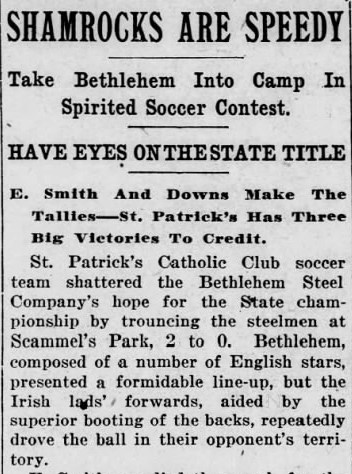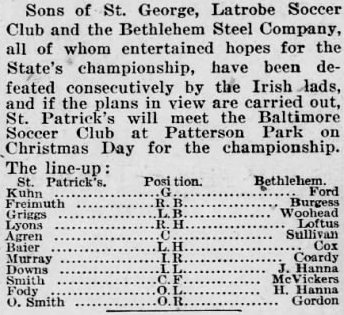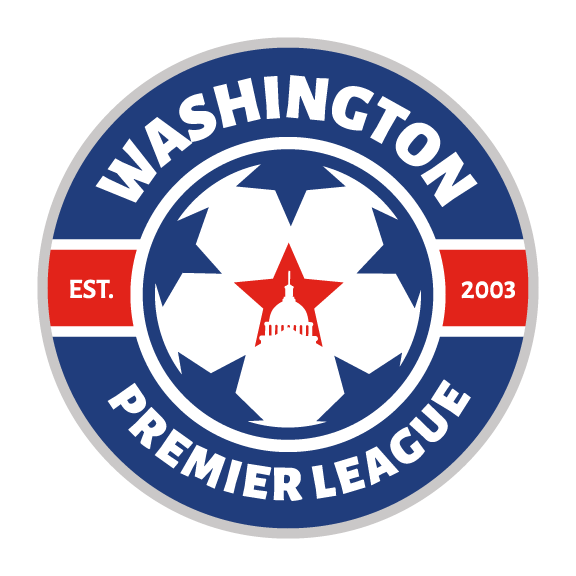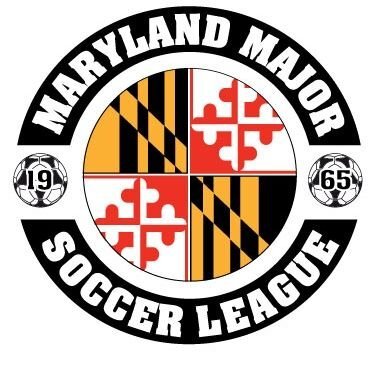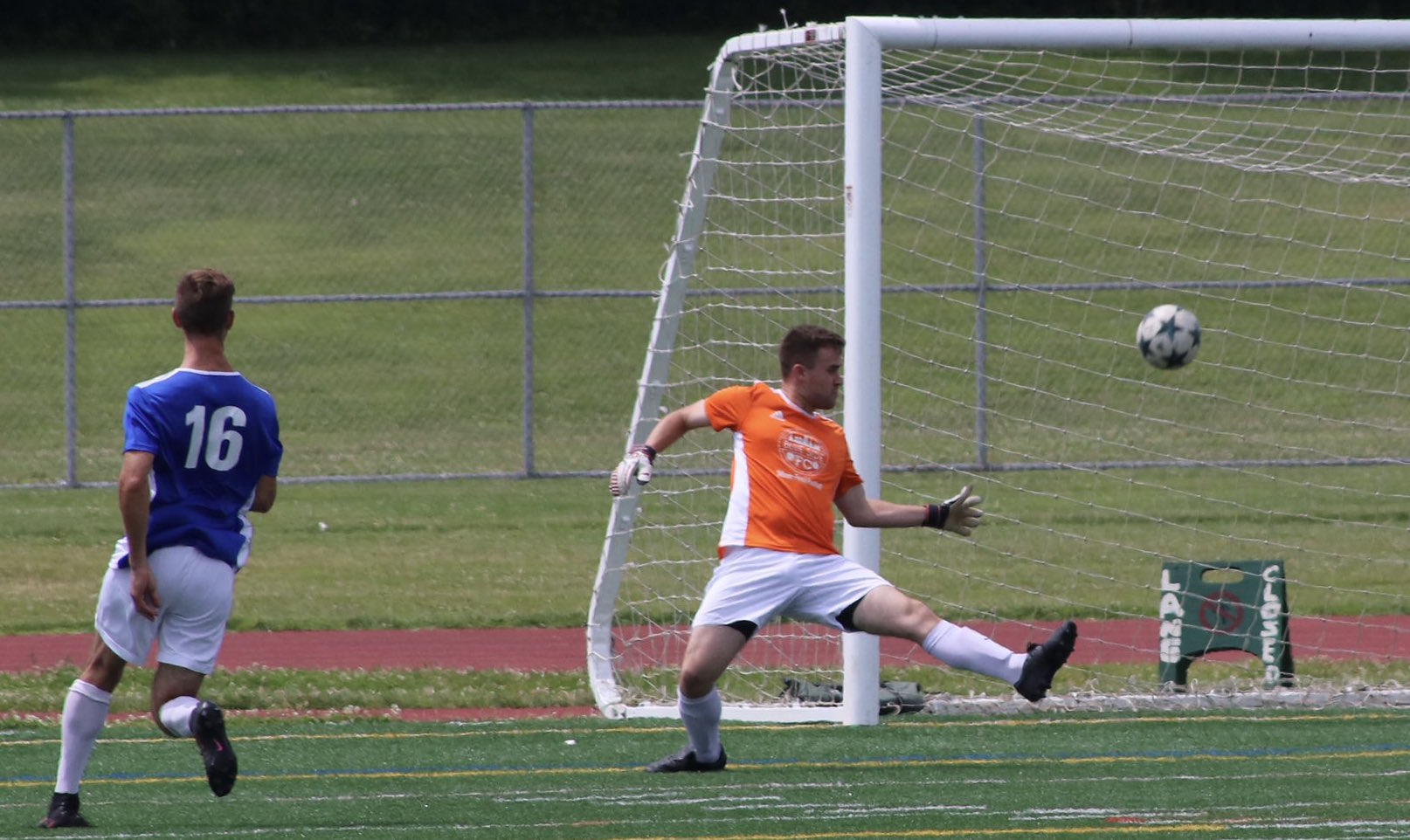Researching the Rowland Cup
Former Protagonist Soccer staffwriter, Dan Creel, is a soccer historian. He researches, digging deep into history, looking to write, record, and promote the truth about the previous 100 years of soccer history in the United States. In fact, that was one of the reasons he became a former writer, he wanted more time to research without deadlines. But when he left, we agreed to always leave the door open for him to bring his work. So today, we offer a snapshot into his work, his preliminary research on the Rowland Cup. - Dan
Centered on Baltimore, the game of soccer has a long, proud history in the state of Maryland. One of these sources of pride is the Rowland Cup. Established in 1914, it is the oldest cup in Maryland and the holders of the cup are considered the state’s club champions.
But, after the initial competition during the 1913-14 season, the record of the Rowland Cup all but disappeared for over a decade. It wasn’t until the 1924-25 season that the cup reappeared when the newly formed Maryland State Soccer Association, reinstituted the trophy to the winner of the association’s officially sanctioned first state cup competition.
What happened in the intervening years? While it won’t give the final definitive answer, this piece presents research which fills in some of the holes in the interregnum between the establishment of the initial Rowland Cup and its reappearance a decade later.
March 1, 1912, The Baltimore Sun
Henry W. Rowland died on February 29, 1912 following surgery for peritonitis. An Englishman by birth, “Dad” Rowland was considered the father of soccer in Baltimore and the driving force behind the Lord Baltimore Lodge, Sons of St. George football club. In fact, at the time of his death, the Sons of St. George and the Baltimore Thistles were in the midst of a five-game series which would determine the champions of Baltimore. As was the sporting standard at the time, this championship was not based on any sanctioning body but by public acclimation. A team had to beat the current champion via a notable win to become the champion.
The Thistles beat the Sons of St. George in the arranged series by winning two games, drawing two and losing one. With the series win, the Scotsmen were considered the soccer champions of both Baltimore and Maryland by wresting that title from the current holders, the Sons of St. George.
Spalding’s Official Soccer Foot Ball Guide, 1912
The Sons of St. George returned as Maryland champions in the 1912-13 season. The club compiled a 15-2-2 record and went undefeated against Baltimore opponents including multiple games against the Thistles.
Spalding’s Official Soccer Foot Ball Guide, 1913
Led by the nascent US Football Association (now the US Soccer Federation), which was quickly sanctioned by FIFA in August of 1913, the sport in the US began a new era of structuring during the 1913-14 season. This included the Baltimore when a group of established soccer clubs moved to form both a league and cup competition.
October 11, 1913, The Evening Sun
In early October of 1913, Julia A. Rowland, “Dad” Rowland’s widow, donated the H.W. Rowland trophy for a cup competition to name the best amateur club in all of Maryland. The competition would have a qualifying round and follow the structure of the English FA Cup. The same soccer mavens in charge of running the Rowland Cup also soon organized a soccer league for teams from Washington, DC, Wilmington, Delaware, and Maryland. Led by Harry Rowland, “Dad” Rowland’s son and manager of the Sons of St. George, the league was known as the Intercity Association Football League.
October 17, 1913, The Evening Sun
The Sons of St. George had a successful season that year. The club won the Intercity League and local newspapers titled them “amateur champions of the South.” The Sons also took the Rowland Cup and the Baltimore city championship. But while it is reported that the Sons were holders of the Rowland Cup it is not certain how they actually won the cup.
September 13, 1914, The Baltimore Sun
It is at this point that the Rowland Cup trail goes cold. The Sons of St. George were edged out of the 1914-15 Intercity League title by the newly-formed Wanderer Soccer Club of Baltimore. The league then folded after two uneven seasons. It is unclear if this victory gave the Wanderers a claim on the state championship or if any matches were held for that championship.
A handful of clubs from the area organized a new Baltimore Soccer League in April of 1915. This league would require its players to be registered with the USFA making it the first Baltimore league fully sanctioned by the national body. The league never got off the ground for the 1915-16 season. Most of the well-established clubs returned to independent play while the Wanderers joined a Saturday league. It is not clear if the state championship was contested that season.
The Baltimore and District League was organized for the 1916-17 season including a planned cup competition. Many of the more-established area clubs joined the league.
There is no indication that the league held the cup competition during the season.
October 6, 1916, The Evening Sun
The Baltimore and District Soccer League planned for a second season during 1917-18. The Sons of St. George had planned to take part again along with St. Elizabeth’s Catholic Club. St. Elizabeth’s was a three-time Baltimore interpark champion and also looked ready to take the state championship. It is unclear if this refers to the Baltimore and District Soccer League title or the state championship title held by the Sons of St. George.
As the Baltimore and District Soccer League continue organizing for the season, The Evening Sun reported that the Sons of St. George were still the state champions. More importantly, the article states that the Rowland Cup was still active as the championship of Maryland, but teams hadn't competed for it the past three seasons.
The second season of the Baltimore and District League never got off the ground. Most of the clubs went back to playing as independents.
On Thanksgiving Day in Patterson Park, St. Elizabeth’s beat Sons of St. George 1-0 and claimed the Maryland state championship. No mention of the Rowland Cup is made. Nor, obviously, was the title achieved via a tournament as envisioned back in 1913.
In the fall of 1918, the Baltimore Soccer Club organized with the intention of winning the Maryland state championship. This team would go on to dominate the Baltimore soccer landscape for the next five years.
The Baltimore Soccer Club went undefeated in its inaugural 1918-19 season.
February 28, 1919, The Evening Sun
In the fall of 1919, St. Patrick’s Catholic Club reorganized its soccer team and made its intention known to challenge other clubs. In November of that year, St. Patricks’ challenged and defeated a number of Baltimore-area teams. The destination was a date with the Baltimore Soccer Club.
It is unclear, though likely, that these were a set of challenge matches rather than a formal cup tournament. But the newspaper articles of the time made it clear that the State championship was on the line.
St. Patrick’s continued its tear through local opposition knocking out Sons of St. George, Latrobe Park and Bethlehem Steel of Baltimore. The ultimate prize was a Christmas Day match with the Baltimore Soccer Club, presumed state champions.
While St. Patrick’s was carving through its opposition hoping to play the Baltimore Soccer Club, the newly-organized Greater Baltimore Soccer League began play in December of 1919. Backed by Baltimore’s Public Athletic League, the GBSL launched with seven teams including the Baltimore Soccer Club and St. Patrick’s. Instead of the envisioned state championship match, the latter club played its first league game on Christmas Day against Bethlehem Steel and lost 3-0.
Any talk of state championship matches disappeared from the papers and was replaced by GBSL league games. The Baltimore Soccer Club ran away with the 1919-20 league pennant completing two undefeated seasons. The team was still considered the state champions.
The Baltimore Soccer Club won the 1920-21 Greater Baltimore Soccer League with another undefeated season. The team continued to be considered the state champions as it prepared for another league season.
Even though its record was finally marred by a 2-0 defeat to the Patterson Tigers, the Baltimore Soccer Club again won the Greater Baltimore Soccer League. The club took the 1921-22 GBSL title on the final game of the season which brought with it the de facto state championship.
The Baltimore Soccer Club jumped to the newly-formed Southeastern Soccer League along with the Patapsco Rangers of South Baltimore and teams from Norfolk and Richmond for the 1922-23 season. The clubs received entry into the early rounds of the National Challenge Cup with Baltimore Soccer Club defeating the Rangers in the Preliminary Round. Baltimore defeated Norfolk in the First Round but withdrew after playing to a draw against Philadelphia’s Fairhill F.C. in the Second Round.
March 26, 1923, The Baltimore Sun
Patapsco won the 1922-23 Southeastern League pennant edging Baltimore Soccer Club in their games. After the league season, the two clubs played a series of games to determine the best team.
January 28, 1924, The Baltimore Sun
But, as before, the articles included no mention of the Rowland Cup as the series was almost certainly not part of that still-dormant competition.
The Patapsco Rangers and Baltimore Soccer Club returned for the Southeastern Soccer League’s second season in 1923-24. The two Virginia clubs were replaced by two teams from Philadelphia. In January, a three-game series between the Rangers and Baltimore for the Maryland state championship was fully sanctioned by the USFA.
But, before the state championship series would be played, the Patapsco Rangers and Baltimore Soccer Club played a Southeastern Soccer League game on January 27.
The Patapsco Rangers won a come-from-behind 2-1 victory. Knocked out of a chance for the league title, Buddy Miller immediately disbanded the Baltimore Soccer Club for the remainder of the 1923-24 season. With the Baltimore club out of the picture, the Southeastern League title was ultimately won by the Philadelphia Terminal club which edged out the Rangers.
The Southeastern League also sponsored a Baltimore city cup championship, chaired by Baltimore Soccer Club manager Buddy Miller, which began on February 10.
March 31, 1924, The Baltimore Sun
The tournament was won by the Alco Soccer Club over the Freebooters by a 2-1 score in added extra time. The Alco Soccer Club was a relatively new, but powerful club having players from other well-established Baltimore teams. In January, Alco was edged by the Baltimore Soccer Club 3-2 but in early February beat the Patapsco Rangers 2-1. The latter match was reported as the first of a three-game series, but, as of late March, no follow-up games between the two had been held.
The Alco Soccer Club defeated the Patapsco Rangers in the last game of the season on March 30. A crowd of 10,000 gathered in Patterson Park to see the city champions take down the professionals 2-0. According to The Baltimore Sun, that win gave the Alcos a claim on the state championship.
In the fall of 1924, clubs from the Baltimore Soccer League and Maryland Soccer League, along with the Baltimore Referees’ Association, formed the Maryland State Soccer Association. The association received official sanctioning from the USFA.
On April 5, the Patapsco Rangers defeated Catonsville 2-0 in the finals at Patterson Park before a crowd of 7,000. During the tournament, Catonsville had defeated the champions of the Greater Baltimore Soccer League, the Wingfoot Soccer Club, along with the state champions, Hampden A.C., formerly the Alco Soccer Club. As such, with the win, the Rangers took not only the Maryland State Soccer Association cup, but also the Rowland Cup itself, and the title of state champions.
From this initial research, I would conclude that the original Rowland Cup was not contested after the 1913-14 season. From that point until the establishment of the Maryland State Soccer Association’s cup tournament during the 1924-25 season, the Rowland Cup was dormant. State champions during that time were decided based on the traditional sporting standard of self-arranged challenge matches and acclimation by the public and the press.
Given the above, here’s how I would presume to define the Maryland state soccer champions beginning in 1912 and through the founding of the Maryland State Soccer Association.
In late February of 1925, the first cup competition under this new organization was formed. Harry Rowland donated a trophy, to be called the Rowland Cup, to be presented to the annual champions.
Selectors:
BDSL = Baltimore and District Soccer League
BS/ES = Baltimore Sun/Evening Sun
GBSL = Greater Baltimore Soccer League
ICL = Intercity League
MSSA = Maryland State Soccer Association
RCC = Rowland Cup committee
SG = Spalding Guide
- Dan Creel
If you love articles like this and want to support Dan Creel’s work, he has a Patreon you should support. I know I do.








